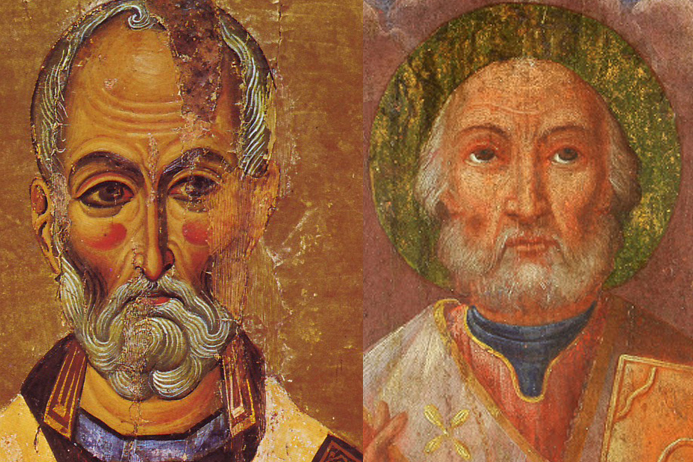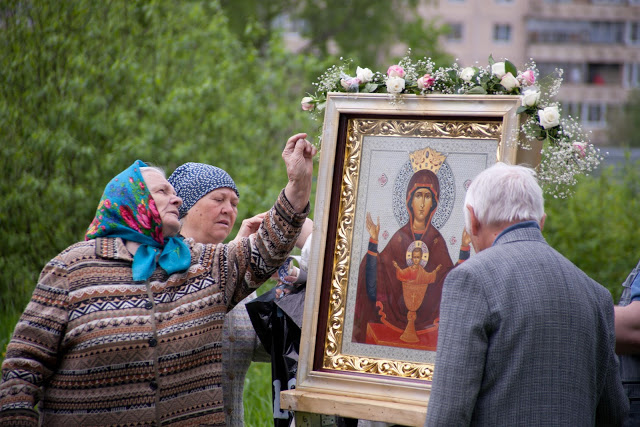
September 3, 2013, marked the 110th anniversary of an apparition of the Mother of God in St. Panteleimon Monastery on Mt. Athos. The celebration in honor of the Painted-by-Light image was established by the Synod of the Elders of that monastery on the 100th anniversary of this miraculous event.
The Holy Synod of the Russian Orthodox Church decided (Decision No. 97, July 27, 2013) to include the commemoration of the apparition of the image of the Most Holy Theotokos Painted-by-Light, which happened in the Russian St. Panteleimon Monastery on Mt. Athos in 1903, in the menologion of the Russian Orthodox Church.
History of the Event
Monk Gabriel who was distributing alms to needy monks near the Great Monastery Gate of St. Panteleimon Monastery took a picture of this process. When he developed the photo, he was shocked to see an image of the Mother of God who had humbly received a blessed loaf of bread.
Monastery archives testify that the Russian monks organized weekly distribution of alms to the needy in the late 19th and early 20th century. Big and small ships from Odessa and Taganrog, where there were metochia of St. Panteleimon Monastery, dispatched foodstuffs and other basic supplies to Mt. Athos every week. The supplies were used by three thousand monks of the monastery and four thousand Russian-speaking brethren who stayed in numerous sketes, cells, and kalivas on the Holy Mountain.

A multitude of poor mendicant monks and pious pilgrims would gather at the Great Gate of the monastery every week. It is estimated that 600–800 people received loaves of bread from the monks. However, idle and unruly drunkards also started to frequent the weekly distribution of bread. A letter from the Koinotita declaring that the tradition was becoming “useless and even harmful” was received in the monastery on August 14, 1903. The governing body of the Holy Mountain demanded that the administrative board of St. Panteleimon Monastery stop the bread distribution and find a more appropriate and less tempting way to help the poor. The letter read, in particular, that, “The almsgiving required by the Gospel is God-pleasing only when it is performed in a reasonable manner, i.e., to the needy people worth giving alms
to. By giving alms to the people who fake real need and don’t really deserve them—to those who count on it and live here for that reason—you inflict harm rather than do good.”
A week later, on August 21, 1903, the monks of the Russian monastery decided to observe their tradition and distribute the bread one last time before finally reading the letter aloud to the crowd. By that time, hundreds were standing in line to receive their usual loaves of bread. It was at that moment that Hieromonk Gabriel took a photo, which was later developed with an image of the Mother of God receiving her blessed loaf humbly together with others. Looking at the unusual photo, the monks recalled what they had been told by Monk Sebastian, who heard from the gatekeepers that “a hermit saw a woman during the distribution of bread.” Some ascetics, who had also seen the Blessed Virgin in the midst of poor monks and travelers, had also wanted to tell a gatekeeper about it but this time, no one saw the Theotokos.
The Theotokos has invariably supported those who dwell in her earthly domain. It was by the order of the Queen of Heaven that the monastery continued to cater to the needs of the poor brethren: the monastery provided meals to the poor after the monastery meals, and the cellarer gave them foodstuffs from the monastery storehouse.
Veneration History
When the monastery was being restored in the late 1980s, the miraculous photo was copied multiple times and distributed to pilgrims along with a brief description of the event. The new generation of Russians who had been traumatized by atheist propaganda regarded this photo as a confirmation of the reality of the spiritual world, according to many pilgrims.

The commemoration of the image painted by light was established by the Synod of the Elders of St. Panteleimon Monastery in 2003, with the blessing of the abbot Archimandrite Jeremiah on the 100th anniversary of the apparition. The name “Painted by Light” was born during the creation of the worship rite of this feast (the word “photography” literally means “painting by light” in Greek). It was then that an icon of this apparition was painted for use during worship. The historical sequence of the event was restored on the basis of chronicles and existing oral accounts.
The text of the worship rite was approved by the Synodal Liturgical Commission.
A chapel with a water fountain was erected on the place of the apparition of the Mother of God in 2011. The water from that fountain has allegedly brought alleviation of physical and mental illnesses.
A church in honor of the Icon Painted-by-Light was founded and consecrated on the ground floor of the Holy Protection Dormitory in the same year.
Translated by The Catalog of Good Deeds





GLORY TO GOD!
So we don’t get an actual picture of the picture?
Please send me the parables and things on icons. Thank you!